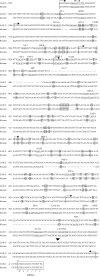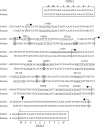Characterization of the promoters of Epsilon glutathione transferases in the mosquito Anopheles gambiae and their response to oxidative stress
- PMID: 15631620
- PMCID: PMC1135021
- DOI: 10.1042/BJ20041850
Characterization of the promoters of Epsilon glutathione transferases in the mosquito Anopheles gambiae and their response to oxidative stress
Abstract
Epsilon class GSTs (glutathione transferases) are expressed at higher levels in Anopheles gambiae mosquitoes that are resistant to DDT [1,1,1-trichloro-2,2-bis-(p-chlorophenyl)ethane] than in insecticide-susceptible individuals. At least one of the eight Epsilon GSTs in this species, GSTe2, efficiently metabolizes DDT to DDE [1,1-dichloro-2,2-bis-(p-chlorophenyl)ethane]. In the present study, we investigated the factors regulating expression of this class of GSTs. The activity of the promoter regions of GSTe2 and GSTe3 were compared between resistant and susceptible strains by transfecting recombinant reporter constructs into an A. gambiae cell line. The GSTe2 promoter from the resistant strain exhibited 2.8-fold higher activity than that of the susceptible strain. Six polymorphic sites were identified in the 352 bp sequence immediately upstream of GSTe2. Among these, a 2 bp adenosine indel (insertion/deletion) was found to have the greatest effect on determining promoter activity. The activity of the GSTe3 promoter was elevated to a lesser degree in the DDT-resistant strain (1.3-fold). The role of putative transcription-factor-binding sites in controlling promoter activity was investigated by sequentially deleting the promoter constructs. Several putative transcription-factor-binding sites that are responsive to oxidative stress were present within the core promoters of these GSTs, hence the effect of H2O2 exposure on the transcription of the Epsilon GSTs was investigated. In the DDT-resistant strain, expression of GSTe1, GSTe2 and GSTe3 was significantly increased by a 1-h exposure to H2O2, whereas, in the susceptible strain, only GSTe3 expression responded to this treatment.
Figures








References
-
- Singh S. P., Coronella J. A., Benes H., Cochrane B. J., Zimniak P. Catalytic function of Drosophila melanogaster glutathione S-transferase DmGSTS1-1 (GST-2) in conjugation of lipid peroxidation end products. Eur. J. Biochem. 2001;268:2912–2923. - PubMed
-
- Sawicki R., Singh S. P., Mondal A. K., Benes H., Zimniak P. Cloning, expression and biochemical characterization of one Epsilon-class (GST-3) and ten Delta-class (GST-1) glutathione S-transferases from Drosophila melanogaster, and identification of additional nine members of the Epsilon class. Biochem. J. 2003;370:661–669. - PMC - PubMed
-
- Listowsky I., Abramovitz M., Homma H., Niitsu Y. Intracellular binding and transport of hormones and xenobiotics by glutathione-S-transferases. Drug Metab. Rev. 1988;19:305–318. - PubMed
-
- Blackburn A. C., Woollatt E., Sutherland G. R., Board P. G. Characterization and chromosome location of the gene GSTZ1 encoding the human Zeta class glutathione transferase and maleylacetoacetate isomerase. Cytogenet. Cell Genet. 1998;83:109–114. - PubMed
-
- Cho S. G., Lee Y. H., Park H. S., Ryoo K., Kang K. W., Park J., Eom S. J., Kim M. J., Chang T. S., Choi S. Y., et al. Glutathione S-transferase mu modulates the stress-activated signals by suppressing apoptosis signal-regulating kinase 1. J. Biol. Chem. 2001;276:12749–12755. - PubMed
Publication types
MeSH terms
Substances
Grants and funding
LinkOut - more resources
Full Text Sources
Miscellaneous

